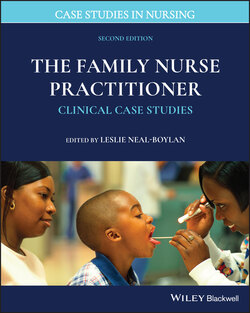Читать книгу The Family Nurse Practitioner - Группа авторов - Страница 44
ОглавлениеCase 5.2 Weight Loss
By Anna Goddard, PhD, APRN, CPNP‐PC
SUBJECTIVE
Roseanne is a 15‐year‐old female who presents to the adolescent clinic with her mother for her annual wellness examination. Her mother reports she is “concerned with Roseanne’s weight.” Specifically she reports that Roseanne needs to “make weight for cheerleading competition.” Roseanne is well‐groomed, polite, and working on homework while the health care provider speaks to her mother. Her last physical examination was at the School‐Based Health Center from a previous school she attended and was reported by her mother to be normal.
Past medical history: Roseanne has a history of a right ankle fracture from 2 years ago, treated with physical therapy and reported complete healing. Roseanne has also a history of right broken forearm and wrist injury from a previous cheerleading injury. She was hospitalized after both previous bone breaks, both requiring surgery. She reports no pain currently. Menarche occurred at age 13 and Roseanne reports that periods were monthly at first and then she started missing periods or having them sporadically. She is now on a triphasic birth control and reports she no longer gets her periods, which she likes because she is a competitive cheerleader and doesn’t have to worry about her monthly menstruation while she is cheering.
Family history: Father is a Type 1 diabetic and has hypertension. Mother has history of anxiety and post‐traumatic stress disorder (PTSD). Maternal and paternal grandparents are deceased. No siblings.
Social history: Roseanne lives in Dallas and moved to a new district with a “better cheerleading squad” in hopes of winning the district championship this year. Roseanne reports that she gets along well with her family and gets all As and A+s. She has friends at her new school and reports she enjoys cheerleading as “it is her life.” Roseanne’s mother reports that she has a chance for cheer‐captain her senior year. Roseanne runs every day before school at 6 a.m. and then has cheerleading practice every day after school from 4:00–6:30 p.m. She competes and has football or basketball games almost every weekend. She studies and completes her homework from the time she gets home from cheerleading practice until 11 or sometimes 12 at night, when she then goes to bed.
Medications: Occasional ibuprofen for sore muscle aches and strains.
Allergies: NKDA; no allergies to foods or environment.
General: Denies fever, chills, or malaise. Denies restriction in food or decreased appetite.
Skin, hair, nails: No pigment changes, no current rashes although occasional tinea from tumbling on gymnastic mats; occasional bruises from cheerleading falls and acrobatics.
HEENT: Denies difficulty with hearing, sinus problems, runny nose, postnasal drip, tinnitus, mouth sores, teeth, ear pain, or sore throats. She reports “doesn’t have time to be sick.”
Cardiovascular: No history of irregular heartbeat, chest pains, swelling of feet or legs. No history of murmurs.
Respiratory: No shortness of breath, night sweats, prolonged cough or wheezing.
Gastrointestinal: No heartburn, constipation, diarrhea, constipation, nausea, vomiting, or blood in stools.
Genitourinary: Unremarkable.
Musculoskeletal: Occasional joint pain and aching muscles: relieved with Icy‐Hot ointment, icing, and over‐the‐counter Motrin; occasional shoulder pain and joint swelling after competitions from certain tumbling and basket catches: treated by physical therapy and over‐the‐counter Motrin.
Hematologic: Does not “bruise easily” but does bruise from heavy athletics dance tumbling; no history of unknown swelling.
OBJECTIVE
General: Muscular teen dressed in athletic pants and tank top. Interactive and appropriate with provider and mother.
Vital signs: Height: 63 inches; weight: 100 lbs; BMI: 17.7 (6th percentile); BP: 92/61; HR: 52; RR: 16.
Skin: Bruising around both knees and shins; skin warm, dry, with sporadic mild acne covered by make‐up.
HEENT: Normocephalic, +PERRLA, TMs gray and visible ossicles; intact, moist mucous membranes; nares patent; oropharynx clear.
Neck: No lymphadenopathy.
Cardiovascular: Regular rate and rhythm; no murmur; femoral pulses equal.
Respiratory: Lungs clear bilaterally.
Breast: Tanner IV symmetrical.
Abdomen: Flat, soft, nontender, muscular.
Genitourinary: Tanner stage IV.
Musculoskeletal: Full range of motion ×4 extremities; no pain or swelling, back straight; muscular.
Neurologic: Cranial nerves II–XII grossly intact, steady gait and balance; reflexes +2 and equal.
CRITICAL THINKING
1 What are the top differential diagnoses in this case and why?___Eating disorder___Excessive exercise___Malnutrition___Malabsorption___Thyroid disorder___Anxiety___Female athlete triad
2 What are the diagnostic tests required in this case and why?__Urine pregnancy test___Glucose___Urinalysis___CBC with differential___Thyroid panel___Prolactin level___Electrolytes
3 What are the concerns at this point?
4 Should Roseanne’s mother be asked to leave the room at this time? Why or why not?
5 What is the plan of treatment?
6 What are the plans for referral and follow‐up care?
7 What health education should be provided to this patient?
8 What demographic characteristics might affect this case?
9 Are there any standardized guidelines that should be used to treat this case? If so, what are they?
10 If this patient was male (instead of female), how would that change management and/or treatment?
